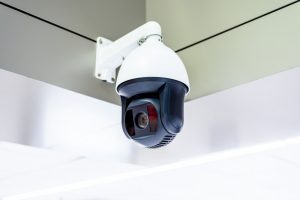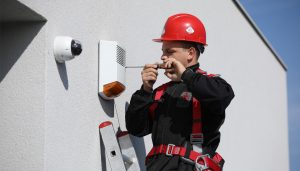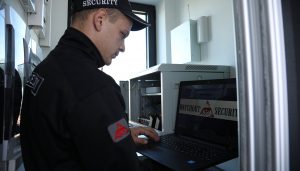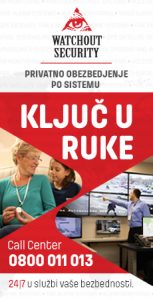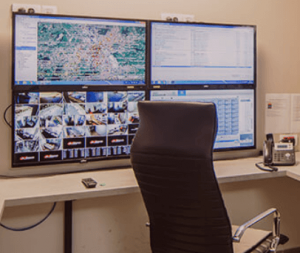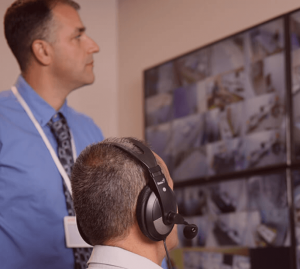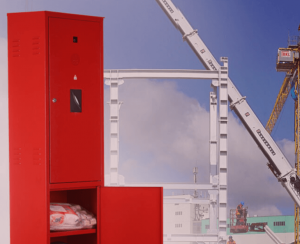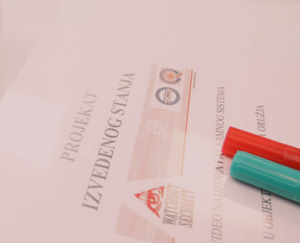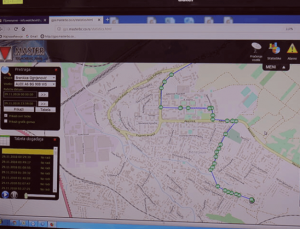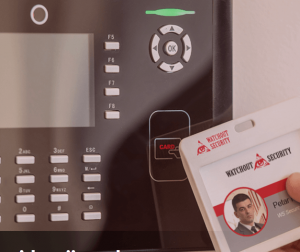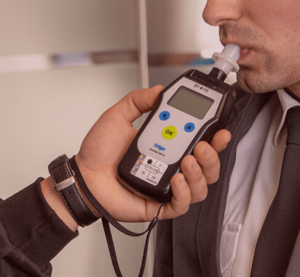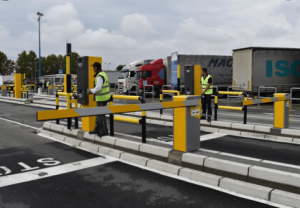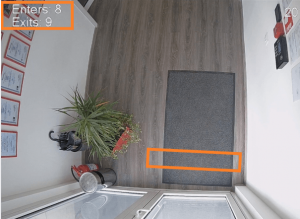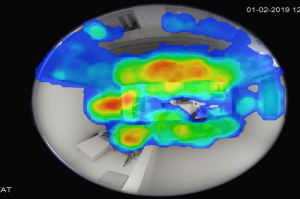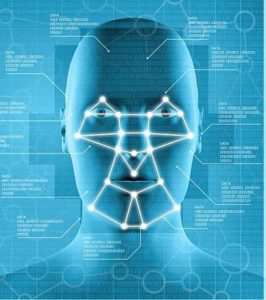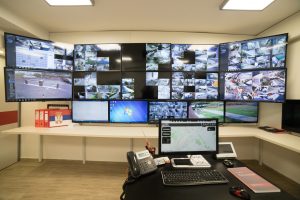Dictionary
Contractor – A person who contracts a job in his own name and on his own account or in someone else’s name, and on his own account.
Service user – A legal / natural person who uses the service, which the contractor has contracted on his account.
Physical protection – is a security service that is provided primarily by the personal presence and direct activity of security officers in a certain space and time, as well as the application of measures and the use of coercive means.
Technical protection – is the provision of persons and property by technical means and devices, their planning, design, installation and maintenance.
Preparatory work – Preparatory work includes the installation of cable trays and installation pipes and cables to the connection points.
Execution of installations – protection includes testing and connection of lines from connection points to means and devices of technical protection and they are performed by legal entities and entrepreneurs who are licensed to perform installation, commissioning, maintenance of technical protection systems and user training.
Physical – Technical protection – is the provision of persons and property by simultaneous or combined application of physical and technical protection.
Finishing – A measure taken with the intention of making a service problem: compliant with the requirements; acceptable for the intended use – repair (as opposed to finishing may affect parts of the non-compliant product or change them); compliant – reclassification (change of the class of non-compliant product in order to comply with the requirements that differ from the required ones).
Correction – A measure taken to eliminate a detected service problem.
Key event – is an event that is extremely important for the realization of project goals for the project management process.
Project Management – contains planning, organizing, monitoring, controlling, reporting on all aspects of the project and motivating all those involved in the project to achieve the project objectives.
Installation, connection and programming of technical protection systems – Installation of technical protection systems includes: installation, installation of devices and equipment, programming, adjustment (parameterization) and testing of technical protection systems as well as its commissioning, verification of devices and equipment, ie systems and technical acceptance, development of operating instructions, staff training.
Troubleshooting a service problem – a measure taken in relation to an existing service problem in order to achieve compliance.
Maintenance Service – Wsa activities to eliminate non-compliances and take measures to reduce the risk of recurrence of non-compliances.
Project quality plan – Necessary activities and resources to achieve the project quality objectives. The quality plan should be incorporated into, or referenced in, the project management plan.
Project Management Plan – A plan of activities, organizing, monitoring, reporting and continuously taking the necessary measures in all project processes that are necessary to achieve the project objectives.
Project product – one or more products (hardware product, service, software or process material or combinations in which one is dominant).
Project – a unique process, consisting of a group of coordinated and managed activities with start and end dates, undertaken to achieve a goal that is in line with specific requirements, including time, cost and resource constraints.
Project goals – are everything that needs to be realized in order to meet the requirements and needs of customers. In some projects, the goals are corrected, so the characteristics of the project products are defined progressively as the project progresses.
Project team – Temporarily established organizational unit for design. Staff may be seconded to the project management organization while the project is ongoing and may change during the project.
Risk – the effect of uncertainty on the expected result (a combination of probability, event and its consequences).
Project Manager – is an authorized individual who is responsible for achieving project objectives.
Non-compliance / Service problem – is a reported non-compliance and / or. user complaint and / or defect.
Defect – a non-compliance related to the intended or specified use.
Non-compliance – non-compliance.
STZ Technical Protection System – is the connection of means and devices that together form a functional whole.
Contract – Agreed requirements between the supplier and the buyer documented in any way.
Project management – is the application of skills, means and techniques for planning, organizing, controlling and supervising in order to achieve project goals, ie to complete the project as successfully as possible despite all the difficulties and risks.
Design validation – activities that confirm that exits from the design process meet the requirements related to the planned use.
Design verification – activities that confirm that the outputs from the design process meet the inputs for will.
Task – are the measures that need to be taken in relation to the existing problem in order to resolve the expressed discrepancies, complaints or shortcomings / defects expressed in the problem.
Document – form and medium on which it is located.
Intervention patrol – reacts on the order of the Operator in the area of responsibility, if necessary in coordination with the competent public services (police, firefighters, ambulance and other utilities).
Panic button – An element of the alarm system whose activation sends a message about the direct threat to human lives in the building.
Duress code – in case of forced deactivation of the alarm system.
Alarm system user code (Responsible persons of the service user) – is the number agreed with the service user for the purpose of prior identification of the service user during communication.
User / access code – the code of authorized persons who can deactivate and activate the alarm. serves to turn on and off the alarm system by the user.
Master code – is a number that is programmed in the system and is owned by an authorized person of the service user who is used to add new user codes and delete old ones.
Patrol logger – a device with internal memory, uses RFID technology to identify checkpoints placed on the objects of users of the Alarm monitoring service.
Tag – Checkpoint set on the facilities of Alarm monitoring service users based on RFID technology, by which it is recognized by the patrol logger.
Outsource – A company that performs the tasks defined by a special contract for the needs of the company Watchout security.
Technical protection – is a set of actions that directly or indirectly protect people and their property, and is performed by technical means, devices and technical protection systems whose main purpose is to prevent illegal actions directed at protected persons or property such as: anti-burglary action; anti-attack action; anti-sabotage and anti-sabotage action.
Technical protection system – is the connection of means and devices that together form a functional unit: ramps and barricades, security doors, all types of locks with serial number or code, special building structures, bulletproof glass and similar structures, equipment for accommodation, storage and transfer of value, objects and documents (cash registers, safes, etc.), devices for detection of metal objects, X-ray devices for luggage control, other mechanical and / or electro-mechanical means and devices prescribed in the procedure of performing technical protection; anti-burglary and anti-intrusion systems with detectors of various designs, access and exit control and registration systems, systems that perform constant surveillance of the protected object from one place, integral protection systems with at least one (1) surveillance place within the protected object, video security systems; for global positioning (GPS satellite tracking). systems for electro-chemical protection of money and other values; global positioning systems (GPS satellite tracking).
Means, devices and systems of technical protection – are considered to be those that have been performed, maintained and serviced in accordance with the provisions of the Ordinance on the manner of performing technical protection tasks and the use of technical means.
Protection of confidential data and information – must have a minimum of three levels: physical barrier of access to the room where the data is located; mechanical computer lock (hardware protection); password, password and biometric protection (software protection).
Risk – the effect of uncertainty on the expected result (a combination of probability, event and its consequences).
Risk categorization – classification of risks according to the level of risk into certain categories in relation to a certain criterion. NOTE 1 For the purposes of this standard, categories 1 to 5 are used. NOTE 2 In principle, the first category includes risks with the lowest level of risk, and the fifth with the highest.
Risk level – A numerical quantity determined by a product of the degree of probability and the degree of consequence.
Categories of protected facilities – minimum protection measures in the treatment of identified risks: I category – HIGHEST LEVEL OF PROTECTION which provides: technical protection which signals unauthorized entry into the protected area and notifies the control center, technical protection which monitors movement in the protected area and individually protected premises ( access control and video security) with video recording, protection of individual values by means of electrochemical protection system (suitcases, containers, cash registers, safes, etc.), integral protection with at least one (1) local control point (control room) and communication system with officials security at the protected facility, written procedures for cases of risk occurrence; II category – HIGH LEVEL OF PROTECTION which provides: technical protection which signals unauthorized entry into the protected area and notifies the control center, technical protection which monitors the movement in the protected area (passage control and video security) with video, integral protection with at least one (1) local control point (control room) and system of connection with the control center, III category – HIGHER LEVEL OF PROTECTION which provides: technical protection which monitors the movement around the protected area (video security) with video record, technical protection which signals unauthorized access to the protected area and notifies the control center.
Technical acceptance of the technical protection system – technical acceptance of the technical protection system is considered to be: verification of the correctness and functionality of all devices and equipment that make up the technical protection system; checking the compliance of the technical protection system with the project, ie sketch; checking staff training; checking user manuals; checking the proof of the quality of the installed equipment.
Alarm notification – traction and electronic signals in the Control Center that activates the Operator for the implementation of planned activities.
Scheme of the monitored facility – scheme of the monitored facility with entered notification zones, as well as instructions and data that determine the nominal duties of each member of the on-duty patrol team.
Patrol team member on duty – a person who participates in the process of patrolling or intervention of the patrol team.
Patrol team leader on duty – a person who coordinates and organizes the work of the Patrol Team.
False alert – conclusion that the alarm alert is incorrect.
Actual event notification – conclusion that the alarm notification is real There must be a record for this alarm. The number of false and actual alerts must be equal to the total number of alerts.
Contractual documentation – Contract / offer: Agreed requirements and obligations between WS and service users documented in any way. The mutually signed contractual documentation is linked to the User Code as well as to the SERVICE TYPE CODE.
ID – determined unique number for the installed alarm system. One service user can have one or more alarm systems (one or more IDs).
ID Name – through which the operator more easily recognizes the user of the service and describes the object more closely to the persons in the field.
Protected building – a building, or space, in which a technical protection system is installed, or a security service is provided.
Alarm system – Installed technical protection system at one control panel. It can be installed for multiple objects and multiple zones.
User code – a unique code for a legal or natural person who potentially uses or has used or uses the services of the WS.
Alarm system user (Responsible persons of the service user) – Responsible persons of the service user are determined through the form No. 33, which is compiled by the responsible person in front of the WS, and which can be changed over time according to Procedure Pr 03.
Alert Zone – An element of the technical protection system that is monitored separately in the building.
Partition – A programmed part of an alarm system that is treated as a separate unit under the same ID.
Event – installed events for which there are established alerts and actions per alert.
Action – determined activities in the PR 03 procedure which are planned to be realized in case of notification from the technical protection system.
Monitoring – twenty-four-hour monitoring of the operation of the technical security system in all facilities where the WS system is installed and taking timely measures in order to reduce the consequences to a minimum.
Password – information given to the user and the operator to identify the user during a call by the operator on duty from the Control Center (can be text or numeric).
Work order – a work order contains the activities of one or more individuals. The work order must contain at least one work task.
Work task – Activities of individuals.
Status – current current, existing status.
Service status:
1.1 A review is underway – the conditions and manner of providing the service are determined and documented with the service user.
1.2 Accepted / pending implementation – mutually accepted conditions and manner of providing the service.
2. Active
- (AF) Service active – can be invoiced;
- (AR) Service active – no invoicing;
- (AE) Service active – invoice via – Electro;
- (AV) Active service – cash payment;
- Judicial termination (ongoing proceedings) – an active service in progress is a court process.
3. Inactive
- Agreed termination with the realization of new requests – Agreed termination with the realization of new requests;
- Termination upon fulfillment of obligations according to the agreement – Termination upon fulfillment of obligations according to the agreement;
- Final Termination – Final Termination; Judicial termination; consensual termination; performed agreed obligations.
Internal document – all outputs from existing processes in WS are internal documents that can be an input document for the needs of other processes in WS or sent outside the company.
External documents – All received documents / information that WS receives from others.
Input document / information – Documents and information on the basis of which the participant / participants create output documents.
Output document / information – Documents and information obtained by processing input documents / information during or after the process.
Information – Data received and understood. Data of importance.
Data – What constitutes a fact.
Document – information and the medium (written, magnetic electronic, or optical disk) on which it is located.
Specification – a document in which the requests are stated.
Record – a document in which the obtained results are stated or evidence of performed activities is given.
Pro-invoice – Schematic and written offering of the price of a product or service before delivery of the product or start of the service.
Invoice schematic – written official document of the amount of the price of the delivered product or completed service.
Security – Security as a function of business is an organized set of jobs that protect a particular entity or value (company, business, etc.), especially its vital parts, from the holders of any illegal and incompatible with the business or activities of that entity, inside or outside and provide the necessary (optimal) security conditions by planning, organizing, implementing and controlling (1) protection of persons, facilities and business, (2) implementing regulations and establishing the necessary discipline, (3) certain (security) measures and (4) regulating and controlling other matters of importance to that entity.
The purpose (goal) of security and its implementation is:
- Protection of human life;
- protection of freedoms and rights of employees in the organization (company);
- protection of buildings;
- property protection;
- protection and enforcement of laws and regulations;
- protection of confidential business data (information) and activities;
- detection of holders and perpetrators of illegal and illegal actions in and towards the organization (company);
- increase productivity.
Physical-technical security – Physical-technical security is a planned and organized undertaking and implementation of measures, actions and procedures for the purpose of protection of certain security facilities.
Security facility – The security facility includes: buildings, building complexes, certain (restricted or fenced) areas, spaces and directions, assets (machines, equipment, tools, vehicles, etc.), documents, valuables and other valuables (money, works of art , precious metals and minerals) and faces (people).
Registration service – The registration service is an organized and planned activity of securing facilities by occupying certain points in front of or inside the facility in order to control the entry and exit of persons and funds (usually vehicles and goods). The goal of the registration service is to prevent uncontrolled entry and exit and the entry-exit of funds (items).
Guard service – Guard service is a planned and organized activity of securing facilities by occupying permanent or temporary points and areas on the perimeter (outer perimeter, border) and inside the security facility, in order to prevent entry-exit of people and removal of property. The goal of the security service is to protect the security facility, primarily movable and immovable property, from unauthorized removal or possible attack and endangerment of any kind from the outside.
Technical protection – Technical protection activities include planned and organized activity of securing facilities by setting up, activating, using and monitoring the system (means) of technical protection. Technical protection includes anti-diversification and anti-burglary protection. Technical protection systems (means) are: video surveillance, detectors of metals, explosives, dangerous and other gases, scanners (“X-ray” devices), devices for motion detection, sensors for various purposes, specially reinforced doors and windows, special locks and other devices for locking, access control devices, etc.
Security plan (report) – Security plan (report) is a document that precisely defines the organization and implementation of security and in principle consists of:
- excerpt (conclusions) from the security assessment of the security facility;
- security composition (number of people, by shifts and positions, manner of shifts);
- equipment and weapons (type, number, method of handover and storage, etc.);
- organization of communication and notification;
- purpose and general duties of security bodies (application form, patrol, guards, etc.);
- the powers of security guards, in particular with regard to the right to use physical force, other means of coercion, as well as firearms;
- special duties of individual bodies and executors;
- procedures in individual specific situations.
Security assessment – Security assessment is an interactive and logical connection (“analysis”) of facts and knowledge about individual elements of the subject – the subject of assessment in order to gain knowledge about the possibility and probability of danger, possible prevention of danger, or, if not possible reduction (mitigation) ) and / or remediation of damage (hazard control).
Danger – Danger is a property or ability of something or someone to potentially cause harm. Dangers can be:
- caused by (intentional) human will (“tactical” dangers);
- unintentional human activities;
- natural disasters and events that cannot be affected (“accidents”).
Risk – Risk is the probability of a hazard occurring under conditions of action or exposure.
Risk assessment – Risk assessment is the process of evaluating the likelihood of a hazard occurring.
Subject – the subject of assessment is a physical object (industrial complex, building, etc.), person, space, event, activity (process), etc.
Technical protection system – is the connection of means and devices that together form a functional whole. Means, devices and systems of technical protection are considered to be those that are performed, maintained and serviced in accordance with the contract documentation.
Technical intervention – means the elimination of technical problems with the system user within the contract within a specified period, and after a clearly identified notification that differs from the alarm notification to the control center.
Professional supervision over the performance of technical protection activities may be performed by a legal entity or an entrepreneur who holds a license to perform supervision activities, in the manner and under the conditions determined by the Law and regulations on planning and construction.
The technical acceptance of the technical protection system is considered to be:
- checking the correctness and functionality of all devices and equipment that make up the technical protection system;
- checking the compliance of the technical protection system with the project, ie sketch;
- checking staff training;
- checking user manuals;
- checking the proof of the quality of the installed equipment.
Technical acceptance is performed by the authorized representative of the investor or the user and the contractor. A record of the performed technical acceptance shall be drawn up and signed by the investor’s representative or the user and the contractor. The Contractor shall issue a certificate to the investor or user that the technical protection system has been constructed in accordance with the provisions of this Rulebook. An integral part of the certificate is the Minutes of the performed technical acceptance.
The plan of the technical protection system determines the optimal level of technical protection, integral protection, as well as the connection with other technological systems on the facility, and in particular determines:
- requirements that must be met by systems that are not technical protection systems, but affect the safety of the facility and the reliable operation of the technical protection system (power supply system, lighting, etc.);
- construction and similar requirements of importance for the proper and reliable operation of the technical protection system (leveling of the terrain, safety distances, landscaping, etc.).
Quality management system consultant – a person who helps in the organization and implementation of the quality management system, giving advice or information.
Organization – a person or group of people who have their own functions with responsibilities, authorities and relationships to achieve their goals
Organization context – a combination of internal and external issues that may affect the organization’s approach, development and achievement of its goals.
NOTE 1 next to the term: The goals of an organization may relate to its products and services, investments, and behavior toward its stakeholders.
NOTE 2 to the term: The notion of organizational context is equally applicable to non-profit organizations or public services, as well as to those that strive for profit.
NOTE 3 to the term: In English, this term is often referred to by other terms such as “business environment”, “organizational environment” or “organization ecosystem”.
NOTE 4 next to the term: Understanding infrastructure can help define the context of an organization.
Stakeholder – a person or organization that can influence, be influenced, or feel influenced by a decision or activity.
User – a person or organization that could receive or receive a product or service that is intended or required for that person or organization.
Supplier – an organization that provides a product or service.
DRP supplier – the supplier of the dispute resolution process.
Improvement – an activity to improve performance.
Continuous improvement – a repetitive activity to improve performance.
Management – coordinated activities to guide and manage the organization.
Quality management – management from the point of view of quality.
Quality Assurance – the part of quality management focused on providing confidence that quality requirements will be met.
Quality management – part of quality management focused on meeting quality requirements.
Quality improvement – part of quality management focused on increasing the ability to meet quality requirements.
Configuration Management – Coordinated configuration routing and management activities.
Activity – the smallest identified subject of work in one project.
Process – a set of interconnected or interacting activities that uses input elements to deliver the intended result.
Project – a unique process consisting of a set of coordinated activities managed, with start and end dates, undertaken to achieve a goal that is tailored to specific requirements, including time, cost and resource constraints.
Procedure – a specified way of executing an activity or process.
NOTE to term: Procedures can be documented or undocumented.
Provide outsourcing – make an arrangement based on when an external organization performs part of an organization’s function or process.
Contract – a binding agreement.
Design and development – a set of processes that converts requirements for a subject into more detailed requirements for that subject.
System – a set of interconnected or interacting elements.
Infrastructure – a system of plants, equipment and services required for the implementation of operational activities of the organization.
System management – a set of interconnected or interacting elements of an organization for establishing policies and goals, as well as the process for achieving those goals.
Quality management system – part of the quality management system.
Work environment – a set of conditions in which work is performed.
Politics – the intentions and direction of the organization, as officially expressed by its top management.
Quality policy – a policy related to quality.
Vision – striving for what the organization wants to become, expressed by top management.
Mission – the purpose of the organization, expressed by top management.
Strategy – a plan to achieve a long-term or comprehensive goal.
Entity item – anything that can be observed or imagined.
Quality – the level to which a set of inherent characteristics of an entity meets the requirements.
Class – a category or rank assigned to different requirements related to an item that has the same functional application.
Request – a need or expectation that is expressed, generally implied or binding.
Non-compliance – non-compliance with the requirements.
Defect – a non-compliance related to the intended or specified use.
Traceability – the ability to track the history, application or location of an item.
Safety of functioning – the ability to do something as required and when required.
Innovation – a new or modified object by which value is realized or redistributed.
Goal – the result to be achieved.
Output element – the result of the process.
Product – an output element of an organization that can be produced without any transaction that takes place between the organization and the user
NOTE to the term: Hardware is of a material nature and its characteristic is that its quantity is countable (eg tires). Processed materials are of a material nature and their characteristic is that their quantity is continuous (e.g. fuel and non-alcoholic beverages). Hardware and recycled materials are often called good. The software consists of information regardless of the medium in which it is delivered (eg computer program, mobile phone application, user manual, dictionary content, copyright in the music composition, driver’s license).
Service – an output element of an organization with at least one activity that must be performed between the organization and the user.
NOTE to the term: The provision of a service may include, for example, the following:
- activity performed on a material product delivered by the user (eg a car to be repaired);
- activity performed on an intangible product delivered by a user (e.g. a statement of income required to prepare a tax refund);
- delivery of an intangible product (eg delivery of information in the context of knowledge transfer);
- creating an environment for the user (eg in hotels and restaurants).
Performance – a measurable result.
Risk – the effect of uncertainty.
Efficiency – the relationship between the results achieved and the resources used.
Effectiveness – the extent to which planned activities have been implemented and planned results achieved.
Data – facts about the case.
Information – data that contains meaning.
Objective evidence – data that supports the existence or truth of something.
Information system – a network of communication channels used within an organization.
Document – information and the medium on which they are located.
EXAMPLE: Record, specification, procedure document, drawing, report, standard.
NOTE to the term: The medium may be a paper, magnetic, electronic or optical computer disk, a photographic or printing matrix, or a combination thereof.
Documented information – information that the organization is required to manage and maintain, as well as the medium on which it is located.
Specification – a document stating the requirements.
EXAMPLE: Quality rules, quality plan, technical drawing, procedure document, work instructions.
Rules of procedure on quality – specification for the quality management system of the organization.
Quality plan – a specification of the procedures and related resources to be applied (as well as when and who should apply them) for a specific subject.
Record – a document stating the results obtained or providing evidence of activities performed.
Verification – confirmation by providing objective evidence that the specified requirements have been met.
Validation – confirmation by providing objective evidence that the requirements for a specific intended use have been met is or application.
Customer satisfaction – the user’s opinion on the extent to which his expectations have been met.
Complaint – an expression of dissatisfaction addressed to an organization, which relates to its products, services or the process of dealing with complaints, where an answer or solution is explicitly or implicitly expected.
Customer service – the interaction of an organization and a user during the life cycle of a product or service.
Dispute – disagreement arising from the complaint, submitted to the DRP supplier.
Characteristic – a property on the basis of which a difference is made.
NOTE to the term: There are various classes of characteristics, such as:
- physical (eg mechanical, electrical, chemical or biological characteristics);
- sensory (e.g., those relating to smell, touch, taste, sight, hearing);
- behavioral characteristics (e.g., kindness, honesty, truthfulness);
- temporal (e.g. accuracy, reliability, availability, continuity);
- ergonomic (eg psychological characteristics, or those related to human safety);
- functional (e.g. maximum aircraft speed).
Competence – the ability to apply knowledge and skills to achieve the intended results.
Review – determining the suitability, adequacy or effectiveness of the subject in order to achieve the set goals.
Monitoring – Determining the status of a system, process, product, service or activity.
Control – determination of compliance according to specified requirements.
Testing – determination according to the requirements for a specific intended use or application.
Preventive measure – a measure to eliminate the cause of a potential non-compliance or other potential undesirable situation.
Corrective measure – a measure to eliminate the cause of non-compliance and prevent its recurrence.
Correction – a measure to eliminate detected discrepancies.
Concession – permission to use or release a product or service that does not comply with the specified requirements.
Finishing – a measure taken with the intention of making a non-compliant product or service compliant with the requirements.
Repair – a measure carried out on a non-compliant product or service to make it acceptable for its intended use.
Disposal – a measure carried out on a non-compliant product or service to prevent their originally intended use.
Verification – a systematic, independent and documented process for obtaining objective evidence and its objective evaluation in order to determine the scope in which the verification criteria are met, the subject and the area of verification, the scope and limits of verification.
Inspection plan – description of activities and work schedule during the inspection.
Verification criteria – what constitutes a fact.
Evidence of verification – records, statements of fact or other information that are relevant to the verification criteria and that can be verified.
Verification findings – results of evaluation of collected verification evidence in relation to verification criteria.
Conclusion of the inspection – the outcome of the inspection after considering the objectives of the inspection and all the findings of the inspection.
Companion – a person appointed by the audited organization to assist the verification team.
Verification team – one or more persons conducting the verification, assisted, if necessary, by technical experts.
Inspector – a person who conducts an inspection.
Observer – a person who joins the verification team but does not have the role of verifier.
Control center – a location from which twenty-four-hour monitoring of the work of the STZ is carried out in all facilities in which the system is installed and timely measures are taken in order to reduce the consequences to a minimum.
Call center – an organized process used to receive and process user requests.
Working week – lasts, as a rule, five working days.
The minimum price of labor is determined per working hour without taxes and contributions, for a calendar year, no later than September 15 of the current year, and is applied from January 1 of the following year.
Schedule of working hours – The schedule of working hours within the working week is determined by the employer, as a rule, five working days. The working day, as a rule, lasts eight hours. In the case referred to in paragraph 3 of Article 56, the employee may work a maximum of 12 hours per day, or 48 hours per week, including overtime work. Article 57 An employee who has agreed to work in the redistribution of working hours on average longer than the time specified in para. 2 and 3 of this Article, working hours longer than the average working time are calculated and paid as overtime work.
Redistribution of working time – The employer may redistribute working time when required by the nature of the activity, organization of work, better use of labor resources, more rational use of working time and execution of certain work within the specified deadlines. Redistribution of working time is not considered overtime work, Article 58. An employee who has agreed to work in the redistribution of working time on average longer than the time specified in para. 2 and 3 of Article 57, working hours longer than the average working hours are calculated and paid as overtime. Redistribution of working hours may not be performed on jobs where part-time work has been introduced, in accordance with Article 52 of this Law. An employee whose employment was terminated before the expiration of the time for which the redistribution of working hours is performed has the right to have his working hours longer than the agreed working hours realized in the redistribution of working hours time or to calculate and pay for those working hours as overtime hours.
Night work – Work that is performed between 10 pm and 6 am the next day is considered night work. If the work is organized in shifts that include night work, the employer is obliged to provide a change of shifts, so that the employee does not work continuously for more than one working week at night. An employee may work at night for more than one working week, only with his written consent.
Unpaid leave – The employer can grant the employee leave without salary compensation (unpaid leave). During unpaid leave, the employee’s rights and obligations from the employment relationship are suspended, unless otherwise determined by law, general act and employment contract for certain rights and obligations.
Earnings – Under earnings in terms of Art. 104 paragraph 1 of this article are considered all income from employment, Under the salary in terms of paragraph 1 of this article is the salary that includes taxes and contributions paid from wages other than income from Article 14 (profit sharing), Article 42. paragraph 3. point. 4) and 5) (use of the employee’s funds and compensation of other costs and the manner of their determination) Salary, Article 118, item 1–4) (for transportation, during business trip, accommodation and food in the field), Article 119 (severance pay, funeral services, work injury), Article 120, item 1) (jubilee award and joint and several assistance) and Article 158 (collective agreement of the previous and successor’s employer). of this law.
Salary for work performed and time spent at work – consists of basic salary, part of salary for work performance and increased salary.
Basic salary – is determined on the basis of conditions, determined by the rulebook, necessary for work on jobs for which the employee has concluded an employment contract and time spent at work. The employment contract may determine the basic salary in a larger amount than the basic salary determined on the basis of the elements from the general act.
Work performance – is determined on the basis of the quality and scope of work performed, as well as the employee’s attitude towards work obligations.
The basis for the calculation of the increased salary – is the basic salary determined in accordance with the law, the general act and the employment contract. The general act and the employment contract may determine other cases in which the employee is entitled to an increased salary, such as an increase in salary based on work in shifts.
Minimum wage – is determined on the basis of the minimum wage determined in accordance with this law, time spent at work and taxes and contributions paid from wages. The employer is obliged to pay the minimum wage to the employee in the amount determined on the basis of the decision on the minimum labor price that is valid for the month in which the payment is made. An employee who receives the minimum wage is entitled to the increased salary referred to in Article 108 of this Law, to reimbursement of expenses and other benefits that are considered salary in accordance with the law. The basis for calculating the increased salary from the previous paragraph is the employee’s minimum salary.
Minimum price of labor – is determined per working hour without taxes and contributions, for a calendar year, no later than September 15 of the current year, and is applied from January 1 of the following year.
Other benefits under Article 119 (severance pay, work-related injuries and occupational diseases, funeral expenses in the event of death).
Under average salary – severance pay is considered to be the average salary in the Republic of Serbia according to the last published data of the republic authority responsible for statistics.
Base – salaries are the basic salary determined in accordance with the law, general act and employment contract (for work on a public holiday1.1, work at night1.26, overtime 1.26, past work 0.04).
Past work – based on the time spent at work for each full year of employment with the employer – at least – 0.4% of the base.

